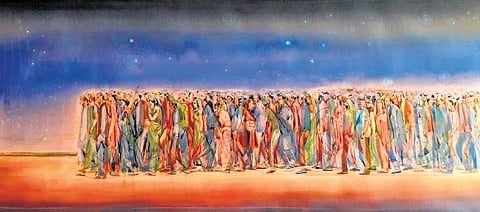

HYDERABAD: Water—as it transcends into myriad forms — its expression is imprinted upon the hearts and souls of those who want to look at the world a little deeper. Presenting such expressions from over 18 contemporary artists, both eminent and young, Kalakriti Art Gallery has put on display their artworks exploring the timeless medium of watercolour.
“The watercolour medium reflects bold realism and spontaneity. A sense of movement and energy became a crucial aspect of these works of art. Expressions in watercolour capture the rich diversity of perspectives, styles, and techniques across generations. From established masters to fresh, innovative voices, each artwork invites you on a journey of imagination and creativity,” said Ruchi Sharma, the curator.
The display is divided into two distinct sections, the artworks by young artists juxtaposing the established luminaries of watercolour, together creating a dialogue that transcends generations, cultures, and experiences. Catalysing exploration and mobilising a myriad of sensibilities, the display invites spectators to delve into the manifold virtues of landscapes. They provide a range of experiences, right from aesthetic appreciation, political commentary, and subjective interpretation to geographical exploration.
Avijit Dutta, renowned for his watercolour paintings, weaves multiple influences and styles in his artworks, showcasing his versatility and creativity. Talking about his paintings at display in the collection, he says, “The work carries forward the ethos of my earlier show Square Foot which has tried to create a visual vocabulary of the slow death of nature in the wake of encroaching concrete growth that not only drowns life, but old memories, values, and history in the drive to displace the old and forgotten with new vigour.”
Talking about the paintings on display, he says, “I delve into boyhood reminiscences of the Calcutta of yore where many houses were laced with small patches of green life climbing walls and roofs— all in a poetic communion with the emotion of the house. Furthermore, the draughtsman sheet in the background was meant to reflect the transforming face of our surroundings and habitable spaces.”
While his paintings provide a memory-like nostalgia for an old Calcutta, Claire Iono is an artist whose paintings, created using different techniques, depict a blend of colours and ideas. Her art reflects the blend of cultural influences she has had in her journey as an artist— tempera with wash technique as used in traditional ancient Indian arts, as well as watercolours and ink used in East-Asian art.
Reflecting on the painting ‘The calm before the storm’, she says, “It is part of a series called ‘Like a secret language not to be deciphered’. In my work, I try to depict a language that transcribes the conscious force that forms everything. This series speaks about a descent, just like light makes its way into matter to transform it.
The three squares symbolise an aspiration towards an action, represented here as descending towards life, disintegrating and transforming themselves before entering into matter. By fragmenting themselves they start resembling a new language, which is like a code containing new information, until the form can reveal the spirit.”
With the in-depth interpretation of the rose-coloured painting, she also talks about this transformative experience within an individual. “It also speaks about this moment where one is alone with his self for space. With the colours and the forms used in this painting, we can feel the waves of calm and tranquillity and the intensity of life that penetrates the whole being, a being evermore transformed by love. At the same time, this intensity and sea of calm seems likely to presage a new storm, opening a deeper door within us, as nature cannot be transformed in a moment,” she adds.
Next, we have SN Sujith, one of the most promising Indian artists, known for effecting a paradigm shift to the medium of watercolour. His art is dominated by tall structures resembling surveillance towers, eerie landscapes with dubious topographies, mob marching to the tune of unseen powers and people who struggle with the bloody baggage of history. Sujith’s landscapes invite you to a make-believe land, far away from the surroundings, yet invoking a familiar realm of emotions. His solitary traverses through barracks, schools and other defining institutions of life, command metaphorical manifestations in his works of art.
He explains one of his works on display: “This painting is from a series of work which I’m still working on. I was trying to create a visual out of a very mundane act of walking. A very simple act, but when I see people walking in a single unit — each one is unique, and has a separate destination and objective — and yet they all walk together as a single entity. I was in Bombay for 14 years.
This is a regular scene in the Bombay landscape, people going from one direction to another as a single entity, without much difference in terms of their objective. There are many differences in their costumes, actions, way of walking and culture at large but at a certain point in time and space, they just walk in one direction. Then, that boring act of walking is transformed into something magical, even futuristic. There is an influence from the futurism movement, showing the idea of speed and how it affects society—the whole idea of modernism, with the introduction of cars, machines, etc.”